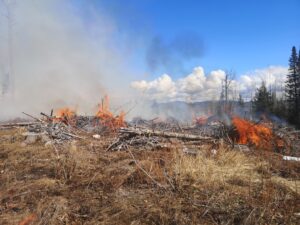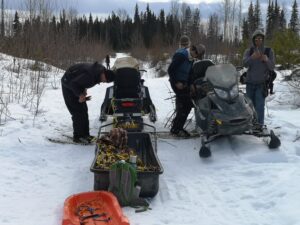Granisle, B.C. – A project to reduce the wildfire risk for the Village of Granisle from future wildfire threats, through innovative and collaborative efforts by the Babine Lake Community Forest (BLCF) and the Village of Granisle, has successfully concluded. In 2020, with $401,450 in funding from the Forest Enhancement Society of BC (FESBC), BLCF started working toward surrounding the village of Granisle with a mixed stand of deciduous trees less susceptible to forest fires than conifers. The work has been completed, and the BLCF is closing the loop on the work started in 2008 to address the Community Wildfire Protection Plan.
“The Forest Enhancement Society of BC is a proven partner in delivering projects on the ground that benefit communities, workers, and the health of our forests,” said Bruce Ralston, Minister of Forests. “We are building on this foundation with an additional investment of $50 million for the Society to expand funding for projects that increase access to fibre, reduce emissions from slash pile burning and reduce the risk to people from wildfire.”
Photo Bottom Left: Cottonwood whip collection crew, LBN Tachet village members, March 2022 with Pic credit to Maria Sonntag;
Photo Bottom Right: Fine fuel raking.
Photo credits: Peter Tweedie.
Gord Pratt, RPF, FESBC Senior Manager, said, “This project was a great opportunity for FESBC to assist the Babine Lake Community Forest in reducing the wildfire risk to the community of Granisle, along with optimizing the use of fibre normally burned and their innovative forestry decision by planting birch into the forest for future stand diversification, meeting multiple objectives.”
While wildfire mitigation was the key objective, BLCF also had several diversified objectives. Peter Tweedie, General Manager, BLCF, and owner of Tyhee Forestry Consultants, noted that the most visible and economically evident objective was the timber resource. However, other objectives were targeted through the project, including consideration of visual resources such as the adjacent high-use recreation area of Babine lake, providing public education opportunities, and firewood for local users, minimizing impacts to existing recreation trails within the project area, managing future silviculture activities to foster food sources and botanic products such as berries and medicinal plants, and making the space available for cultural uses by First Nations and the public at large.
“Diversified forest management objectives respond to the variety of resource elements and resources, both, timber and non-timber, that are considered in the broader forest management process in B.C. We have to always remember that B.C.’s forests are more than just trees; the forested landscape is a mix of resources the public relies on,” said Tweedie.
He further explained that the challenge in this project was an additional objective of creating a long-term, self-perpetuating, low-maintenance wildfire buffer zone between the village of Granisle and the surrounding conifer-dominated landscape.
“The actual scale of the project was a challenge because we cleared such a large area so close to the community,” commented Tweedie. “By planting and establishing a deciduous forest, we were looking to form the nucleus for an element of deciduous forest, in this case birch, for future economical harvest to diversify our community forest’s product stream. We were also challenged in finding a suitable seed source for the birch as it’s not often planted in the local area, but we did and were pleased with the results.”
Birch was chosen to be planted, as this species has proven economic for higher-value products, and it has the benefit of being able to propagate or re-grow itself after cutting.
During the initial discussions for the project, the planning team worked to engage the community to ensure people were aware of the smoke that would be generated as a result of the pile burning.
“At the public meetings we hosted, the local citizens were made aware that there would be smoke, but that we would endeavour to reduce the impact of this smoke as much as possible,” said Tweedie. “The consensus was that although the smoke was not desirable, it was a short-term price to pay for a longer-term gain of the project and its success. In the end, the community in general was supportive and we appreciated their patience.”
Through the challenges, the Mayor and Councillors stood by to steadfastly guide, support and strongly advocate for the community and the forest.
“Mayor and the Council served as not just project initiators, but as guides, offering encouragement and support. This project would never have happened without the support and involvement of the Village of Granisle. In addition, the collaboration and support from the Lake Babine Nation, the Ministry of Forest, Nadina Resource District Manager and staff, and BC Wildfire Service out of Burns Lake as well as significant guidance from the regional wildfire office in Smithers ensured the success of the project,” Tweedie added.
Mayor Linda McGuire applauded the community involvement in the process as well, attributing a portion of the project’s success to their voice and input. “By being involved in this process, it demonstrated the willingness of our community to engage with the decisions from the onset. We would recommend any community considering wildfire mitigation to ensure they are at the table with their community’s voice and input,” said McGuire.
To McGuire’s point, the community was able to observe the entire wildfire mitigation project right from the beginning, including the logging, removal of logs to the mills, pile burning and lastly, the significant benefit to the community as the residual logs were cut and piled for the residents to use as firewood.
In completing the project, BLCF harvested 36,500 cubic metres (approx. 665 truckloads) of conifer sawlog and approximately 8,000 cubic metres (approx.200 truckloads) of roadside debris was moved to Pinnacle Pellet (now Drax) in Burns Lake. Furthermore, this project created employment for local First Nations and a positive perception of the BLCF because the concerns citizens had regarding wildfire were listened to and acted on.
“We, as a Village, want to highlight that such work can be done by others, and it is worth doing. The funding from FESBC was crucial in addressing wildfire mitigation in our community due to the limited budgets small, rural B.C. communities face each day. Without this funding, it would have been extremely challenging for our community to go it alone with only our taxpayers’ dollars,” said McGuire.
FESBC would like to gratefully acknowledge the financial support of the Province of British Columbia through the Ministry of Forests.



